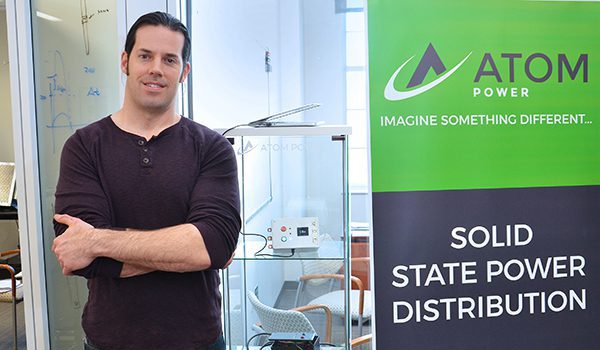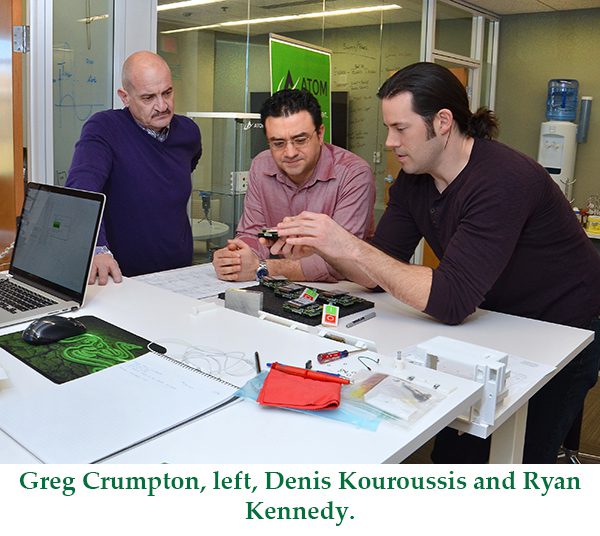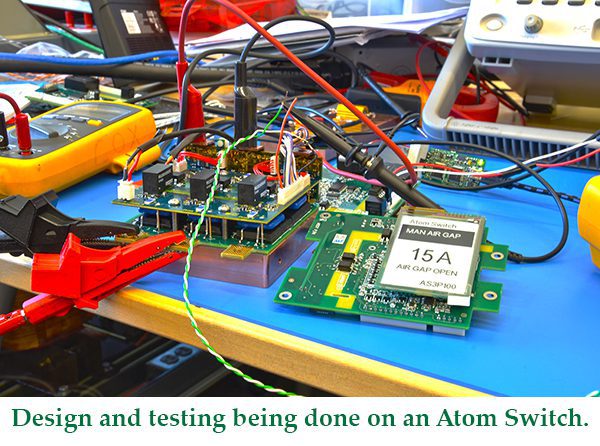Kennedy Forms Company to Develop Revolutionary Solid-State Power Distribution Systems

Having assembled a team of fellow UNC Charlotte engineering graduates and other industry experts, Ryan Kennedy founded the company Atom Power, which is making revolutionary advances by creating the world’s first solid-state power distribution system for buildings.
A 2004 Electrical Engineering graduate of The William States Lee College of Engineering, Kennedy has been involved in electrical switching equipment and circuit breakers for large buildings for more than 20 years. He worked as an electrician for five years before starting his college career. While at UNC Charlotte as a student, he continued to work on large high-profile projects such as the electrical systems design for the 47-story Hearst Tower in uptown Charlotte. After graduation, he worked on the Wells Fargo Securities trading floor in the Duke Energy Center.
In 2012, Kennedy decided to do something different with traditional building engineering, and formed the company Atom Engineering, PLLC.

“Atom Engineering was founded as an alternative to the traditional engineering firm by thinking a little differently about things and taking more chances with products and methods,” Kennedy said, “It was primarily focused on electrical systems, but did all types engineering. As a new company, we did whatever kind of work we could get to pay the bills.”
Kennedy’s work brought him into contact with Virtual Power Systems out of California, where he met Denis Kouroussis. “Denis has a Ph.D. in electrical engineering and is a brilliant power engineer,” Kennedy said. “Working with him was a crash course in product design, which was fantastic because I have a passion for product development.”
Kouroussis and Kennedy were both fascinated by the potential of bringing solid-state technology to the world of building electrical systems. “We had a lot of theoretical discussions about the possibility of using wide band gap semiconductors like silicon carbide and gallium nitride in buildings systems,” Kennedy said. “If it worked, it would be a huge leap forward in power switching equipment such as circuit breakers and protective relays. Other companies had tried to commercially develop pure solid-state circuit breakers and had failed. We decided it was probably possible to do it, so we built a prototype. We couldn’t get it to blow up, so we formed Atom Power to further advance our prototype development of solid-state circuit breaker technology. We called the circuit breaker the Atom Switch.”
They also brought in Greg Crumpton, a friend of Kennedy’s who had worked with him many times on the mechanical side of building systems. “Greg understands what a building needs from the systems level,” Kennedy said. “He also knows a lot of customers and has great sales and marketing talents.”
With Kennedy as chief executive officer, Kouroussis as chief technology officer and Crumpton as chief marketing officer, they formed Atom Power in 2014.

“The Atom Switch has become the world’s fastest circuit breaker,” Kennedy said. “It trips in about 700 nanoseconds, which is more than 16,000 times faster than current electro-mechanical circuit breakers. We developed unique ways to use solid-state materials to recognize and trip current. These type of devices will make electrical systems in buildings much safer.”
In current power distribution systems, electro-mechanical circuit breaker switches physically open to safeguard electrical circuits from damage when protective relays detect fault conditions such as current overloads or short circuits. These systems are slow to respond to faults, and switches must be manually reset when they do trip. The goal of Atom Power is to leap beyond this approach by using digitally controlled solid-state equipment that provides dynamic, intelligent power systems that are safer and easier to use.
“Following on our first prototype, we built an enhanced model, showed it to some investors, picked one investor to work with, and got our first round of funding in April 2015,” Kennedy said. “That kept us afloat for about a year.”
In April 2015, Atom Power set up shop in the Portal Building on the UNC Charlotte campus. “Portal was perfect for us, because we wanted to be close to the Lee College of Engineering and the labs in EPIC,” Kennedy said. “EPIC has great, robust infrastructure and the Electrical Engineering Department is very focused on power at the systems level, which is great fit with us.”
A number of college of engineering faculty are working in cooperation with Atom Power, including primary collaborators Babak Parkhideh of Electrical and Computer Engineering and Maciej Noras of Engineering Technology and Construction Management.
“As an alum, coming back here was like coming to a whole new campus,” Kennedy said. “The whole university area is revitalized since I was here. It’s an exciting place to be. There is a lot of high-tech buzz going on, which is a great thing.”
At its home in the Portal Building, Atom Power is able to work with Ventureprise, UNC Charlotte’s small-business incubator and entrepreneurial accelerator support group. “We’re working with Ventureprise to address the challenges of setting up a small business,” Kennedy said. “I think as they are helping us, we are also helping them to evolve. We’re both trying as much as we can to make Atom Power a local company that will be good for the community.”
Atom Power’s ties with UNC Charlotte also extend to it employees, seven of whom are UNC Charlotte electrical and mechanical engineering graduates.
Taylor Santore graduated from UNC Charlotte in May 2015 in mechanical engineering and started with Atom Power that August. “It is a lot of fun, as a mechanical developer, to be working here,” he said. “Everything we work with is something we designed ourselves. And all of the parts we design have to go through testing, which involves a lot of mechanical engineering.”
Working with new technology can involve a steep learning curve, which is part of the excitement of the work, Santore said. “There is a lot of learning as we go. We have to go back to square one sometimes, but that’s part of the evolution of the product. In the end, it’s really cool that we get to create, design and test, and then see the device work. We love it.”
A December 2015 electrical engineering graduate, Eshwar Ramesh was an intern at Atom Power before going to work for them full-time. “We have a lot of new things we’re working on, which makes it interesting,” he said. “We also get to work on many aspects of the engineering, because everything is so new. No one has done it before, so we have to develop all the engineering ourselves.”
In addition to the semi-conductor circuit breaker the Atom Switch, the team is also developing a panelboard to house multiple switches for building systems. Called the Atom Panel, the solid-state panelboard allows users to simply plug in Atom Switches, which work instantly and are then networked together. Everything can then be controlled through an IPad computer interface operating system called the Atom OS. Atom OS lets users control and even change the characteristics of their electrical infrastructure such as turning circuit breakers on and off, changing circuit breaker time-current characteristics, renaming panels, automatically developing dynamic riser diagrams, and even programming artificial intelligence decision making for electrical infrastructure.
“We have completed the alpha phase of all three products and are now in beta phase, and are doing a whole bunch of testing as part of the development process,” Kennedy said. “We are demonstrating the products to a number of companies.”
With a grant from the Department of Energy, Atom Power will be doing some of its testing in conjunction with Lee College of Engineering faculty and students in the EPIC building.
“We have made it work, which is a huge step,” Kennedy said. “This is the application-based engineering we learned in school, and by designing, building and testing we have made breakthroughs. This is absolutely what we learned in college back when we were all piled in the Smith Building.
“There is always risk, but the discoveries we have made have been good. We are trying to change some things that needs to be changed. We’re trying to make the world a better and safer place. We are doing this for all the right reasons.”